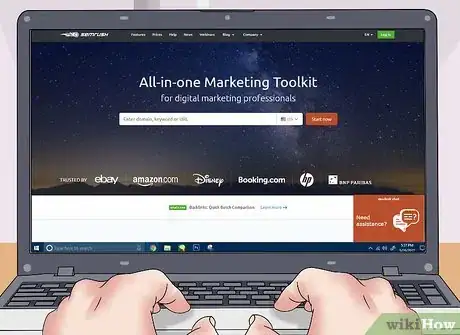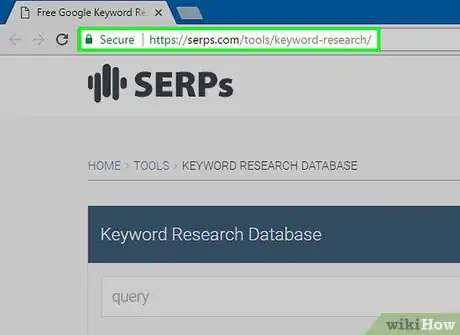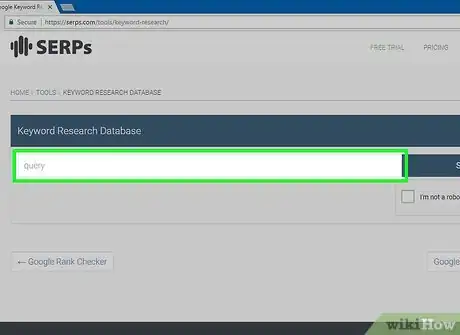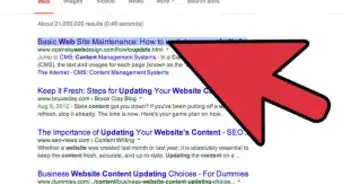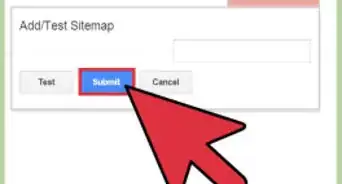This article was co-authored by wikiHow staff writer, Jack Lloyd. Jack Lloyd is a Technology Writer and Editor for wikiHow. He has over two years of experience writing and editing technology-related articles. He is technology enthusiast and an English teacher.
This article has been viewed 21,460 times.
Learn more...
Once you have a website for your business, your work isn't finished. It's time to maximize that website by implementing relevant keywords so that you can attract a larger number of customers. Although it might feel overwhelming at first, keyword research is a simple process once you get started. You'll start by brainstorming possible keywords for your business. Next, you'll determine the effective keywords. Finally, you'll maintain your keywords and run a successful website.
Steps
Brainstorming Keywords
-
1Write down words or phrases that describe your company. These don't have to be keywords--you just need general terms that adequately encompass your company and/or product on a basic level. Think as broadly as possible when defining what your company might represent. You can always eliminate words later in your process.
- Ask yourself, employees, and/or clients questions like these:
- What are the company's mission statement and goals?
- What services does the company provide?
- Who are the company's client base?
- How are clients using the company?
- Which companies are most similar to the company?
- For example: if you specialize in marketing, several of your phrases could be different types of marketing subcategories.
- Include a few keywords that address services that your company hopes to fulfill. For example, you might include terms for services you want to provide or needs you want to fulfill.
- Ask yourself, employees, and/or clients questions like these:
-
2Make a list of your customers' needs. Knowing what people are looking for when they visit your website will help you create keywords that cater to your customers' prospective searches.
- It might also help to come up with potential search queries (e.g., "how to take a photograph") to better empathize with your customers.
Advertisement -
3Add a list of possible keywords below each general term or phrase. Again, don't worry about being precise for now. Your main goal should be to commit as many words to paper as possible.[1]
- If you're having trouble getting started, write down the name of each of your top products, along with descriptors (e.g., "silver iPad Pro"). It's also a good idea to use a thesaurus to identify additional related words.
- Referencing your interactions with customers or clients should help you come up with some common search queries.
- Don't forget to include both the singular and plural versions of your keywords so that clients are more likely to find you.
-
4Create a separate list of tangential keywords. These are words or phrases that don't directly relate to your product or field, but qualify as byproducts or subsequent searches.[2]
- Sites such as http://soovle.com/, https://trends.google.com/trends/, and https://neilpatel.com/ubersuggest/ can generate obscure keywords in relation to a main keyword.
- These keywords are often referred to as "niche topics", meaning that they modify topics that fall outside of your field's focus but not outside of its category altogether.
- For example, a keyword focused on "athletic shoes" has an obvious association with "running" or "bouldering", but a less-obvious phrase might be "getting in shape".
-
5Look up your competitors' keywords. Chances are, if you have a competitor in your field, they've already done the keyword research. While you should have keywords that are specific to your own business, using the same general keywords and some of the niche topics as your competitor will expedite your process.[3]
- Your competitors' keywords are accessible by using a paid app like KeywordSpy or SpyFu, as well as by using free sites like https://www.semrush.com/.
- Another option for discovering your competitor's keywords is to mine them from their reviews.
- You can also reverse-engineer keywords by looking at the keywords your competitor hasn't yet used and then implementing them.
Determining Effective Keywords
-
1Cross out any irrelevant keywords. These include keywords that are too difficult or advanced for your consumer base, keywords that don't quite apply to your company or product, and keywords you're already using.
-
2Get rid of high cost-per-click keywords. Unless your marketing budget is suitably large, you likely won't want to start out with the most expensive keywords.
- You can view the cost-per-click (CPC) of a keyword or phrase by typing it into a site like https://serps.com/tools/keyword-research/ and reviewing the results.
-
3Look for competitor keywords that you don't use. When you looked up your competitors' keywords, you likely found some that you aren't using. However, using high-ranking keywords that your competitors aren't using may give you an advantage.
-
4Plug your remaining keywords into an analytical tool. Again, using a site like https://serps.com/tools/keyword-research/ for this step will make your process easier, though you can set up an ad through Google to use the AdWords Keyword Planner as well.
- This step will help you weed out any keywords that don't quite meet your return on investment standards.
-
5Evaluate your final keywords. One thing to remember during this process is that there is a difference between an algorithm's interpretation of an organic keyword and a human being's interpretation of the same. If you see any keywords that don't look like they belong, consider removing them during this time.
- This is also a good time to ask your employees, marketing experts, or customers what they think about your list. The more input you have, the better.
-
6Implement your keywords. The final test of whether or not your keywords are relevant, broad, and/or applicable enough will be putting them to use.
- You'll want to keep a close eye on your site's analytics during this time. If site traffic notably increases, your keywords are working.
Maintaining Keywords
-
1Update your keywords to fit your current consumer base. You should do this about once a quarter to ensure that your previously relevant keywords are still relevant.[4]
- You may also find that some keywords that weren't working for you at the beginning of your campaign are now directing more traffic.
-
2Incorporate customer feedback. Looking at updated reports on customers' interests, common search queries, and most frequently purchased items should give you an idea of which keywords you should prioritize.
- Looking at customers' favorite items especially will help inform your keyword prioritization.
-
3Raise your maximum CPC budget. As your site's traffic increases, you may find yourself in a position to spend more on higher CPC keywords. If this is the case, it's probably worth experimenting with some of the higher CPC keywords you ruled out earlier.
- You'll want to keep a close eye on how these keywords perform initially, since you risk not achieving a profitable ROI.
-
4Run a search of your main keywords. Google updates often, meaning that a keyword which previously set your site at the top of the results page might now bring up an information box or separate article.
Warnings
- Keyword research is not an exact science. A lot of this process will entail trial-and-error.⧼thumbs_response⧽
References
- ↑ https://blog.hubspot.com/marketing/how-to-do-keyword-research-ht#sm.0000b0q93w19ncfg4yzcvwfeglkh7
- ↑ https://ahrefs.com/blog/keyword-research/
- ↑ https://www.v9seo.com/blog/2015/08/26/how-to-find-competitors-keywords/
- ↑ https://blog.hubspot.com/marketing/how-to-do-keyword-research-ht#sm.0000b0q93w19ncfg4yzcvwfeglkh7
About This Article
If you’re doing keyword research for your website, start by making a list of words that describe your company and your customer’s needs, like “athletic shoes” and "running” if you’re selling running shoes. Then, look up those words on a search engine to find other related terms, such as “getting in shape,” which can help your site come up in related searches. You can also increase your chances of coming up in searches by using your competitors’ keywords, which you can find on free sites, like SEMrush.com. Additionally, use online analytical tools, like SERPs, to make sure your keywords will generate the maximum number of clicks. To learn more, like how to weed out high cost-per-click keywords, read on!




